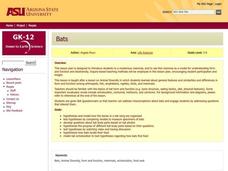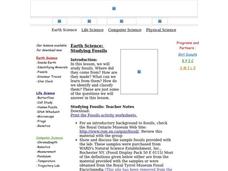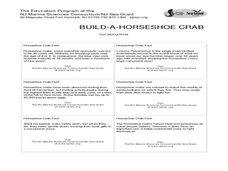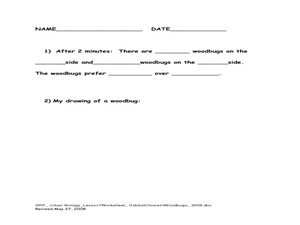Curated OER
The Greatest Show on Earth: The World's Smallest Animals
Students create instruments to capture different types of insects. In this The Greatest Show on Earth: The World's Smallest Animals lesson, students compare the attributes of certain insects and record the data on a chart. After catching...
Curated OER
Marine & Aquatic Habitats Activities - Terrestrial Forests vs. Kelp Forests
Students discuss concept and specificity of habitats, both marine and terrestrial, list similarities and differences in the habitats of a kelp forest and a terrestrial forest, compare types of organisms that occupy corresponding types of...
Curated OER
Metamorphosis
Learners complete a unit about the insect metamorphosis process. They read and discuss a handout and sequence the events of metamorphosis for a variety of insects. Students also view and hold a tobacco hornworm, and complete a...
Curated OER
Madley Brath #39 - Stem and Leaf Plots, Mean, Median, Mode and Range
In this measures of central tendency worksheet, students draw a stem and leaf plot of a set of test scores. They compute the mean, median, mode, and range of the data set, and round the answers to the nearest tenth.
Curated OER
Paper or Plastic: Exploring Renewable Resources.
Students discuss, develop, invent, and implement a plan for making informed personal economic decisions about renewable resources.
Curated OER
Fossil History
Learners examine the similarities and differences between living organisms and fossils. In this fossil activity students reenact the process of creating a fossil.
Curated OER
Bioluminescence
Students differentiate chemiluminescence from bioluminescence. In this biology lesson, students explain how fireflies and other animals emit light. They discuss the applications of engineered bioluminescence.
Curated OER
What Does It Eat?
Pupils use crickets, mealworms, and pill bugs and observe what they choose to eat. In this science lesson plan, students record data, create graphs, and do a write up on what they see happening.
Curated OER
Create a Soil Aggregate
Students simulate the conditions which occur in a soil aggregate. They explain how IPM affects the environment. They identify the cast of characteristics to develop their aggregate.
Curated OER
Vertebrate History in Rocks
In this reading comprehension worksheet, students read the noted section in their science textbooks and respond to 4 short answer and 3 fill in the blank questions regarding fossils embedded in rock formations.
Curated OER
Carnivorous Plants
Pupils examine how carnivorous plants get their nutrients from animals. In this food web lesson students examine how the plants attract their prey and are given many onilne sources to research.
Curated OER
The Crusty Fossils
Learners identify some of the different species of crabs and tell how they adapt themselves to their environment. They discuss the evolution and stages of development of the crabs. They identify the Phylum Arthropoda and the Class...
Curated OER
Honey Bee Biology
Students review the basic parts of an insect and explore the anatomical characteristics of a honey bee. The second part of the lesson focuses on ways to identify a honey bee from other stinging insects.
Curated OER
Bats
Learners model how the bones in a bat wing are organized. They develop questions about bat body parts based on photographs. They hypothesize how bats locate their food.
Curated OER
Spineless - YES... Helpless - NO!
Young scholars distinguish between invertebrate and vertebrate organisms while examining the zoological classes of a number of invertebrates. They illustrate a food web of these organisms and investigate the impact of humans on the...
Curated OER
Introduction to Pinning Insects
Pupils are introduced to how to properly pin insects by reviewing insect morphology, insect orders and recognizing that the second and third thoracic segments contain large locomotor muscles that bind to the pin.
Curated OER
Global Weather Patterns and Disease
Students conduct research projects to determine the effects of climatic changes on the spread of infectious diseases throughout regions. After conducting their Internet research, students develop mini-presentations on their given disease...
Curated OER
Studying Fossils
Students study fossils. They examine samples of specific fossils--including a shark tooth, a brachiopod, and horn coral, among others. They visit corresponding websites and complete a worksheet regarding each of the fossils.
Curated OER
Night Hike
Students explore Upham Woods at night and investigate about the special adaptations of nocturnal animals. They identify three nocturnal animals and how they are adapted to the night. Students explain what night vision is and how it works.
Curated OER
Build-A-Horseshoe Crab
Students discover many facts about horseshoe crabs. Students identify the main body parts of horseshoe crab. They explore the habits of the horseshoe crab and their importances to the ecosystem. Adaptations for younger students are...
Curated OER
Spiders
Students study spiders. In this spider lesson plan, students divide into four study groups, research their topic, and give a report over their findings. The four topics are Characteristics of spiders, life cycles of spiders, fun facts...
Curated OER
Bats
Young scholars hypothesize and model how the bones in a bat wing are made up. In this exploratory lesson plan students test their hypothesis, develop questions about bat parts and watch a video on bats.
Curated OER
Habitat Choice in Woodbugs
Students investigate woodbugs. In this scientific investigation lesson plan, students explore the steps scientists take when conducting an investigation using live specimens. Students explore habitat preferences for woodbugs in various...
Other popular searches
- Arthropods Venn Diagrams
- Arthropods Characteristics
- Arthropods Grade 6
- Marine Arthropods
- Lesson Plans on Arthropods
- Biology Arthropods
- Classification of Arthropods
- Arthropods Models
- Ocean Arthropods
- Arthropods Lesson Plans
- Arthropods Habitat
- Soil Arthropods
























